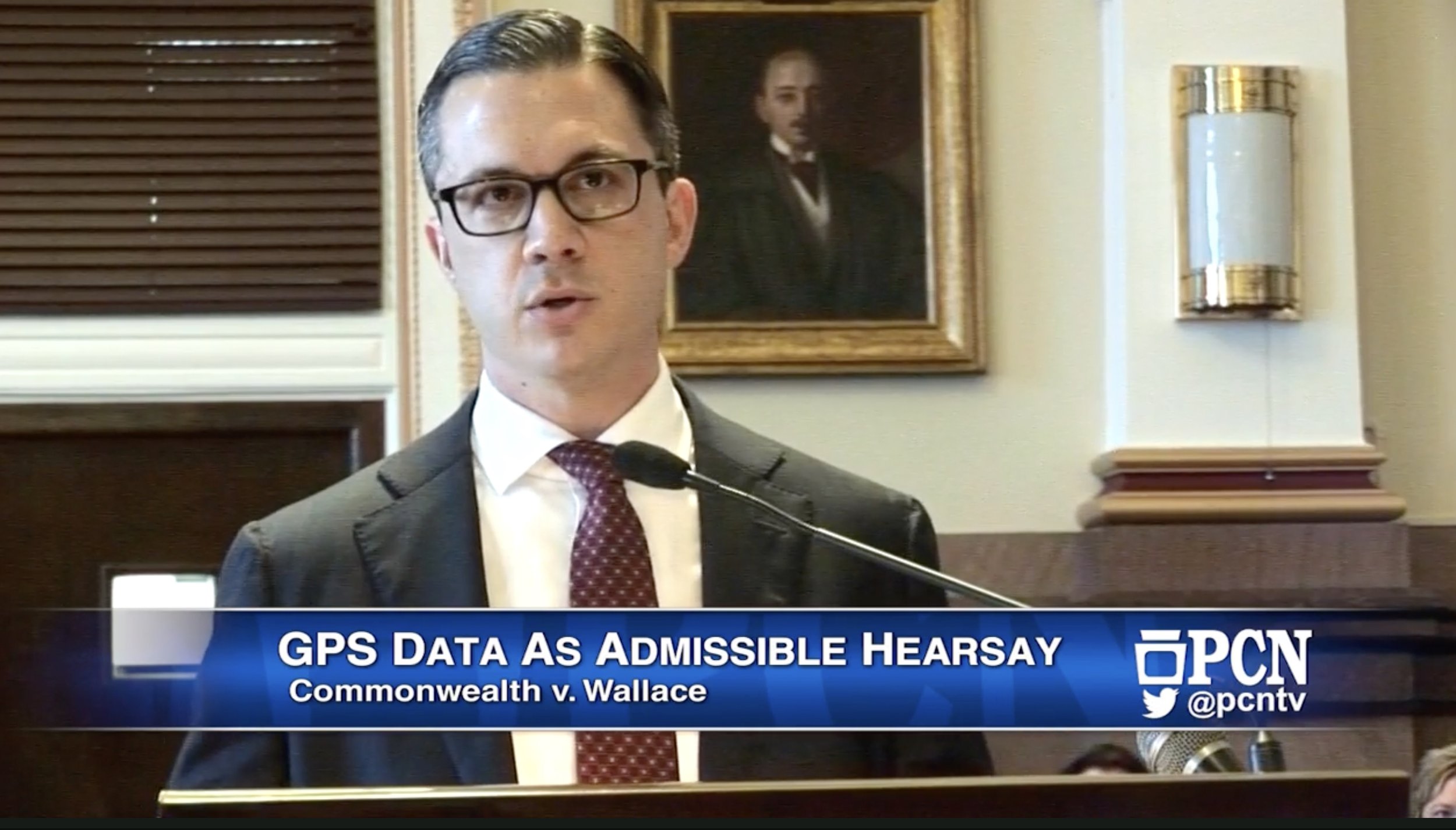
Philadelphia Criminal Defense Blog
Federal Habeas: Third Circuit Finds Trial Counsel Ineffective for Failing to Impeach Key Prosecution Witness or Object When Judge Instructed Witness to Testify Favorably for Commonwealth
Criminal Defense Attorney Zak T. Goldstein, Esquire
The United States Court of Appeals for the Third Circuit has decided the case of Rogers v. Superintendent Greene SCI, finding that the district court should have found the defendant’s trial attorney provided the ineffective assistance of counsel when he failed to impeach the Commonwealth’s main witness with prior inconsistent statements or object when the trial judge threatened to have the witness charged with perjury if the witness did not testify favorably for the Commonwealth. This is an important decision; federal habeas petitions can be very difficult to win. Fortunately, the Third Circuit recognized that defense attorneys must pay attention during trial and advocate strategically for their clients. They may not remain silent in the face of obvious misconduct or fail to use critical impeachment evidence against the Commonwealth’s star witness.
The Facts of Rogers
In Rogers, the defendant had been convicted of third-degree murder. The evidence introduced at trial suggested that a man named Hayes saw Rogers standing on a corner. Hayes approached Rogers, the men had words, and they both pulled out guns. They began shooting at each other. A third man across the street started shooting, as well. Hayes drove away. Rogers, Hayes, and the third man survived, but Rogers’s friend Green was killed by a stray bullet from Rogers’s gun.
Multiple witnesses told the police that Hayes fire first and Rogers defended himself. A final witness, Singleton, initially refused to make a statement. He later told the police that Hayes never fired a gun. Three years later, after Hayes was arrested and charged in the shooting, Singleton changed his story and said that Hayes had shot at Rogers. Singleton continued to maintain, however, that Rogers fired first and that Hayes acted in self-defense.
The Commonwealth charged both Hayes and Rogers with first-degree murder, but it tried them separately. Hayes’s trial was first. Singleton and a witness named Summers both testified. Singleton told his recent, new story that Hayes shot at Rogers but only in self-defense. Summers changed her story. She had told the police that Hayes shot first, but at trial, she said she didn’t see who fired first. The jury acquitted Hayes of all charges.
Rogers’s trial took place a week later. Summers again testified that she did not see who fired first. For the first time ever, Singleton told the jury that Rogers acted in self-defense and Hayes fired first. Later in the day, the trial judge excused the jury and then admonished Singleton for the inconsistent testimony. The judge told Singleton that he had committed perjury and that if Singleton continued to play games, he would receive the maximum consecutive sentence for perjury. The judge told Singleton to “do some long hard thinking” before resuming his testimony because if he said Hayes shot first again, it would be perjury. Rogers’s attorney inexplicably failed to object.
Trial resumed the next day. This time, Singleton testified that his claim that Hayes fired first was wrong and actually Rogers had fired first. Singleton said he made a mistake because he was nervous. Rogers’s attorney did not object or cross-examine Singleton on the change in testimony. The jury found Rogers guilty of third-degree murder, and the judge sentenced him to 16 - 32 years’ incarceration.
The Appeals
Rogers appealed. The Superior Court affirmed. He then filed a Post-Conviction Relief Act (“PCRA”) petition. In the petition, he argued that he received the ineffective assistance of counsel when trial counsel failed to object when the judge threatened Singleton and told him how to testify and that his trial counsel should have cross-examined Singleton on the change in testimony. The PCRA court denied the petition. The Superior Court eventually affirmed. Rogers filed a similar petition in federal court under 28 U.S.C. § 2254. The federal district judge denied the habeas petition. Rogers appealed to the Third Circuit.
The Third Circuit reversed. It recognized that when a state prisoner’s attorney fails to provide the effective assistance of counsel, a federal court has the power to grant relief. The power to grant relief is limited, however. A federal court must presume that the state courts’ factual findings were correct and defer to the state court’s rulings on claims adjudicated on the merits unless they were 1) were “contrary to, or involved an unreasonable application of, clearly established Federal law, as determined by the Supreme Court,” or 2) were “based on an unreasonable determination of the facts in light of the evidence presented in the State court proceeding.” This standard is difficult to meet.
The Third Circuit’s Ruling
Here, the Court found that Rogers met that standard. Trial counsel had testified at an evidentiary hearing that his decision was strategic; he did not see any basis for objecting to to the judge’s threats, and he thought that the jury would not find Singleton credible. He therefore decided to rely on Summers’s testimony. The lower courts accepted this explanation, but the Third Circuit rejected it. It found that Pennsylvania appellate courts have warned against such judicial conduct for decades and granted new trials in cases where judges behaved in this manner. The Court also disapproved of the fact that trial counsel did not appear to have watched the first trial or reviewed the testimony from that trial. The Pennsylvania Supreme Court has prohibited trial judges from questioning witnesses in a manner that suggests the judge has an opinion on the testimony, and so trial counsel should have objected. Counsel also should have cross-examined Singleton on the change in the story in order to highlight the inconsistencies for the jury. Singleton was the only real witness against Rogers, so discrediting Singleton could have resulted in a different verdict. As Singleton’s testimony was the most important, Rogers suffered prejudice in that he may have been acquitted or received a new trial on appeal had trial counsel properly objected and impeached Singleton.
Therefore, the Third Circuit vacated the conviction and granted Rogers a new trial. Ultimately, defense attorneys are not expected to be perfect. Trials happen quickly, and attorneys have to make quick decisions on how to try to fight a case. Sometimes defendants lose trials even when the defense attorney did a good job. Or the defense attorney may have had a good reason for making a decision regarding objections or a line of cross-examination but not obtained the hoped for result. But attorneys may not sit silent while judges threaten witnesses or express opinions on the defendant’s guilt or innocence, and they must use strong exculpatory evidence properly. They cannot just do nothing and hope for the best when effective potential defenses are available. This case recognizes that fact, and so Rogers will receive a new trial.
Facing criminal charges? We can help.
Goldstein Mehta LLC Criminal Defense Attorneys
If you are facing criminal charges or under investigation by the police, we can help. We have successfully defended thousands of clients against criminal charges in courts throughout Pennsylvania and New Jersey. We have successfully obtained full acquittals in cases involving charges such as Conspiracy, Aggravated Assault, Rape, and Murder. We have also won criminal appeals and PCRAs in state and federal court. Our award-winning Philadelphia criminal defense lawyers offer a free criminal defense strategy session to any potential client. Call 267-225-2545 to speak with an experienced and understanding defense attorney today.
United States Sentencing Commission Votes to Eliminate Status Points
Criminal Defense Lawyer Zak T. Goldstein, Esquire
The United States Sentencing Commission has voted both to eliminate status points for most federal criminal defendants under the federal sentencing guidelines as well as to make that change retroactive. Until recently, the Sentencing Commission had not had a quorum of commissioners since 2018, so the Commission had been unable to propose changes to the federal sentencing guidelines. Now that a quorum of commissioners has been appointed by the President and confirmed by the Senate, the Sentencing Commission is once again able to enact changes to the guidelines. Generally, the changes which receive a majority vote from the commissioners go into effect unless overturned by Congress within a 180 day review period.
What are status points?
Under the current federal sentencing guidelines, each defendant that is found guilty by a judge or jury or who pleads guilty receives an Offense Level and a Criminal History Score. The offense level is based on the seriousness of the offense. Offenses typically have a base offense level for the offense of conviction, and then there are all sorts of potential enhancements that may apply depending on the way in which the offense was committed.
For example, a wire fraud conviction would have a certain base offense level, but then the offense level would increase based on the amount of money lost by the victims of the fraud as well as other potential factors such as whether the defendant used sophisticated means to commit the fraud or had a leadership role in the scheme. Other enhancements may potentially apply in any given case.
During the pre-sentence report process, each defendant will also then be assigned a criminal history category based on their criminal history points by the United States Probation Officer who prepares the pre-sentence report. The criminal history category is generally based on the number and type of convictions that the defendant has previously received as well as the length of any sentences served for those convictions.
The sentencing guidelines, which provide a recommended sentence in months that the judge must consider imposing, are then calculated based on where the offense level and criminal history category meet. This chart shows the recommended sentencing range for each offense level and criminal history category.
Federal Sentencing Guidelines Matrix
The judge is not required to impose a guideline sentence, but judges take the guidelines extremely seriously.
Under current law, most offenders who are under probation, parole, or federal supervised release supervision at the time of the commission of the new offense receive two additional points towards their criminal history category for being under supervision at the time of the offense. Two points can often be the difference between specific criminal history categories, resulting in much higher guidelines for a defendant who is under supervision than one who is not. This can have a big impact on the recommended sentencing range.
For example, a defendant with an offense level of 34 and a criminal history category of II would be facing sentencing guidelines of 168 - 210 months’ incarceration. If the individual was under supervision at the time of the offense, the criminal history category could be increased to category III, and then the defendant would instead be facing 188 - 235 months’ incarceration. This means the defendant could receive an additional two years at the high end of the guidelines, so the difference can be significant.
Now, the federal Sentencing Commission has voted to eliminate status points for most defendants. Specifically, the Sentencing Commission abolished all status points for people who had fewer than seven accumulated criminal history points driving their criminal history category. For those with seven or more points, only one status point would be added rather than two. In making this change, the commission determined that status points had little to no relevance in the accurate determination of a criminal history profile.
Will the change to status points under the federal sentencing guidelines be retroactive?
On August 24, 2023, the Sentencing Commission also voted to make the change retroactive and to allow inmates who would be affected by the change to file motions to reduce their sentences starting in February 1, 2024. Defendants may not file motions to reduce their sentences before that date, but if a defendant received status points that affected their guideline range, the they may petition the district court for a reduction in sentence based on the retroactive change in the sentencing guidelines. This change also assumes that Congress does not vote to overturn the proposed amendment to the guidelines.
Ultimately, the Sentencing Commission determined that status points do very little to predict whether a particular defendant is likely to re-offend. Therefore, whether or not someone was under supervision at the time of the offense should no longer be factored into the guideline calculation going forward.
Facing criminal charges? We can help.
Goldstein Mehta LLC Criminal Defense Lawyers
If you are facing criminal charges or under investigation by the police, we can help. We have successfully defended thousands of clients against criminal charges in courts throughout Pennsylvania and New Jersey. We have successfully obtained full acquittals in cases involving charges such as Conspiracy, Aggravated Assault, Rape, and Murder. We have also won criminal appeals and PCRAs in state and federal court. Our award-winning Philadelphia criminal defense lawyers offer a free criminal defense strategy session to any potential client. Call 267-225-2545 to speak with an experienced and understanding defense attorney today.
PA Superior Court: Suppression Required if Police Don’t Knock and Announce
Philadelphia Criminal Defense Lawyer Zak T. Goldstein, Esquire
The Pennsylvania Superior Court has decided the case of Commonwealth v. Goodis, holding that the trial court should have granted the defendant’s motion to suppress because the evidence overwhelmingly showed that the police failed to “knock and announce” prior to entering the defendant’s house to execute a search warrant. The consequences to the government of a failure to knock and announce are very different in Pennsylvania and federal courts. In federal court, a knock and announce violation does not lead to suppression. But in Pennsylvania state court, a violation of the knock and announce rule requires that the trial court suppress the evidence.
The Facts of Goodis
In Goodis, the defendant had been convicted of various counts relating to the possession and distribution of child pornography in state court. Prior to trial, he moved to suppress the evidence, arguing that police failed to knock and announce before entering his house to execute a search warrant. The trial court denied the motion, finding that the police acted too quickly but were justified in relying on concerns of officer safety. The defendant appealed.
What is the knock and announce rule?
The knock and announce rule requires police to knock on the door, wait a little bit, and announce their identity, purpose, and authority before entering. Generally, this is accomplished by the police knocking, yelling something along the lines of “police, open up, search warrant,” and then giving the occupant of the building a little bit of time to respond. If the police obtain a no-knock warrant or hear something that suggests the person inside is attempting to flee, grab a weapon, or destroy evidence, then police may dispense with the knock and announce requirement. They also generally do not have to wait very long. But they do have to knock, announce, and give the occupant of the building some time to open the door before they break in.
It is notable that the appellate court may have had some doubts about the defendant’s actual guilt. Even after the trial court denied the motion to suppress, the defense was able to show at trial that police had damaged the hard drive which allegedly contained the child pornography, and he called expert witnesses who testified that the contraband could have been placed there by someone accessing his wireless network which was unsecured at the time. The police also did not find a large quantity of contraband images and videos. In many cases, they find thousands of images and videos. In this case, they only found a few.
The Superior Court’s Ruling
On appeal, the defendant challenged the trial judge’s ruling on the motion to suppress. Pennsylvania Rule of Criminal Procedure 207 and Article I, Section 8 of the Pennsylvania Constitution require that police, before entering a dwelling to execute a search warrant, announce their identity, purpose and authority and give the occupant a reasonable period of time after such announcement to let them in, unless exigent circumstances require immediate forcible entry. The purposes of this requirement, known as the “knock and announce rule,” are to prevent resistance by an occupant protecting his dwelling, to prevent violence and physical injury to the police and occupants, to protect an occupant’s privacy expectation against the unauthorized entry, and to prevent property damage resulting from forced entry. The knock and announce rule is not limited to entry that involves breaking down a door or damage to the dwelling; it applies to any entry into a dwelling without the occupant’s permission, including entry through an unlocked door. Moreover, even where police knock and clearly announce their identity as police, failure to announce their purpose before entering the premises violates Rule 207 and Article I, Section 8 of the Pennsylvania Constitution and suppression is required unless exigent circumstances for the failure to announce are shown.
The Commonwealth must prove compliance with the rule or that one of four exceptions applied. The exceptions are: 1) that the occupants fail to respond after repeated knocking and announcing; 2) that the police are virtually certain that the occupants already know their purpose; 3) that the police have reason to believe that an announcement prior to entry would imperil their safety; or 4) that the police have reason to believe that evidence is about to be destroyed.
Here, the trial court had found that the police announced their presence but did not announce their purpose or wait for a long enough time for the defendant to let them in the house. The court ruled, however, that the police acted with exigent circumstances because they believed that the defendant could have posed a threat to officer safety. On appeal, the defendant argued that this officer safety exception should not have applied.
The Superior Court reviewed the transcripts from the hearing as well as the body camera videos which were introduced by the parties. The videos showed that the police knocked, the defendant walked to the window and put up a finger, signaling that they should wait a second, and then he went out of view to get dressed. Before he got dressed, the police knocked the door down and then held him at gunpoint. The Commonwealth had argued that he could have been trying to destroy evidence or grab a weapon when he went out of view, but the Superior Court rejected this argument. The Court concluded that there was no reason to believe the defendant posed a threat to officer safety where the police were investigating a serious but non-violent crime, the defendant came to the door, signaled to the police for them to give him a second, and then the defendant appeared to be getting dressed. This is particularly true given that the police had not told him to come back or open the door immediately. Indeed, they did not announce their purpose at all. The defendant even appeared to say “hold on a second,” and one of the officers responded, “OK, all right.” As the officer agreed, the defendant had no reason not to believe it was okay for him to get dressed before opening the door. Thus, the officers did not have any objective reason to believe that there was an issue of officer safety that would eliminate the requirement of announcing their purpose.
The Superior Court therefore ordered that the evidence should be suppressed. The defendant will receive a new trial, and the Commonwealth will likely be unable to proceed.
The case shows the importance of carefully reviewing body cam footage before trial and understanding the differences between state and federal court. Without the body cam footage, the defendant would have had a very hard time convincing a panel of appellate judges that the police did not have legitimate officer safety concerns. He would have been left only with their testimony and limited ways in which to contradict it. Further, in federal court, the remedy for a knock and announce violation is not suppression. Instead, a defendant can sue the police, which does not do them much good while they are in prison serving a sentence for distribution of child pornography.
Facing criminal charges? We can help.
Goldstein Mehta LLC - Criminal Defense Attorneys in Philadelphia
If you are facing criminal charges or under investigation by the police, we can help. We have successfully defended thousands of clients against criminal charges in courts throughout Pennsylvania and New Jersey. We have successfully obtained full acquittals in cases involving charges such as Conspiracy, Aggravated Assault, Rape, and Murder. We have also won criminal appeals and PCRAs in state and federal court. Our award-winning Philadelphia criminal defense lawyers offer a free criminal defense strategy session to any potential client. Call 267-225-2545 to speak with an experienced and understanding defense attorney today.
PA Superior Court: Police May Search Car and Defendant Without Warrant When Defendant Has Gun and Drugs in Plain View
Philadelphia Criminal Defense Lawyer Zak T. Goldstein, Esquire
The Pennsylvania Superior Court has decided the case of Commonwealth v. Green, affirming a Philadelphia trial court’s finding that police officers had reasonable suspicion to believe that the defendant was in possession of illegal narcotics and a firearm where the defendant was sitting inside of a car that police believed to be abandoned with drug paraphernalia in plain view, the odor of burnt marijuana emanating from the car, and the outline of what police believed to be a gun in his pocket. Although the Pennsylvania Supreme Court recently granted allocatur on the issue of whether the plain view exception to the warrant requirement applies to automobiles, The moral of the story is that it is ill-advised to keep your guns and drugs in plain view where the police can see them.
The Facts of Green
On June 1, 2019, two Philadelphia Police officers were on routine patrol in a marked police vehicle and investigating complaints of narcotic sales and illegally parked vehicles near the West Poplar Apartment Complex. One officer was familiar with the housing complex as he had worked in that district for more than ten years and made numerous narcotics and firearms arrests in that apartment complex and area. One of the officers noticed a white Chevy Malibu he believed had been parked in the complex, unmoved, for about two weeks. The officers pulled up to investigate the vehicle, believing that it may have been abandoned. The officers approached on foot, noticed the vehicle’s inspection stickers were peeling off and it had damage to the body of the vehicle. They smelled the odor of burnt marijuana emanating from the car. The vehicle had tinted windows, and as one officer went to the front to look through the windshield, he noticed the defendant in the front passenger seat fully reclined. The officer then noticed small vials and plastic baggies, which he recognized to be consistent with narcotics packaging for crack cocaine, as well as “blunt guts” scattered around the vehicle.
As the officer took a closer look at the defendant through the windshieled, he noticed the outline of a firearm in the front pocket of the defendant’s tight-fitting sweatsuit. The officer could see the entire imprint of the firearm. That officer notified his partner he believed he saw a firearm and radioed for backup.
One police officer attempted to speak with the defendant by knocking on the windshield and requesting that the defendant step out of the vehicle and provide paperwork. The defendant opened his eyes slightly and then closed them again as if he were checking if the officers were still there and then pretending to be asleep. The police were unable to get him to respond.
The officers attempted to make contact for fifteen minutes. They were on the verge of calling for a SWAT team, but their supervisor directed them to break the windows and pull the defendant out of the car. They did so, and they recovered a 9mm pistol from the defendant and placed him under arrest.
The Criminal Charges
The defendant was charged with carrying a firearm without a license and carrying a firearm on the public streets of Philadelphia without a license (VUFA § 6106 and § 6108). Both these offenses are violations of the Uniform Firearms Act. The defendant filed a motion to suppress the firearm, and the trial court denied the motion to suppress. The judge found him guilty following a bench trial, and he appealed.
The Superior Court’s Ruling
On appeal, the defendant argued that the trial court should have granted the motion to suppress. First, the Court explained the typical rules that may apply to this type of police encounter. Pennsylvania Courts have developed three categories of interactions between citizens and police officers to better determine if an individual’s rights are being infringed. The categories are:
1) a “mere encounter” (or request for information) which need not be supported by any level of suspicion but is not an order and can be completely ignored.
2) an “investigative detention” which must be supported by a reasonable suspicion; it subjects the individual to a stop and a period of detention but does not rise to the level of the functional equivalent of arrest, and
3) “custodial detention,” or the functional equivalent of an arrest, which must be supported by probable cause.
A person is subject to an investigative detention, which requires reasonable suspicion, when a reasonable person in their position would not feel free to leave.
In this case, the Superior Court concluded that the officers did not need any level of suspicion to approach the parked car on foot, but they needed reasonable suspicion to break the windows and pull the defendant out of the car. The Court, however, found that they had reasonable suspicion based on the totality of the circumstances - the defendant was in a car which had numerous obvious motor vehicle code violations, there was drug paraphernalia in plain view, he pretended he did not see the police even though he opened his eyes, and he also had a gun on him.
Accordingly, the police were justified in breaking into the car and removing him from the vehicle. Whether or not the police may retrieve contraband from a car when the contraband is in plain view is still an open question; as previously mentioned, the Pennsylvania Supreme Court recently granted review on that issue. So far, however, the Superior Court has repeatedly held that police may enter a car to retrieve obviously visible contraband even without a search warrant. The police ordinarily may not search a car without a warrant, but when guns and drugs are out in the open, the police may not need to get a warrant.
Facing criminal charges? We can help.
Goldstein Mehta LLC Criminal Defense Lawyers
If you are facing criminal charges or under investigation by the police, we can help. We have successfully defended thousands of clients against criminal charges in courts throughout Pennsylvania and New Jersey. We have successfully obtained full acquittals in cases involving charges such as Conspiracy, Aggravated Assault, Rape, and Murder. We have also won criminal appeals and PCRAs in state and federal court. Our award-winning Philadelphia criminal defense lawyers offer a free criminal defense strategy session to any potential client. Call 267-225-2545 to speak with an experienced and understanding defense attorney today.









